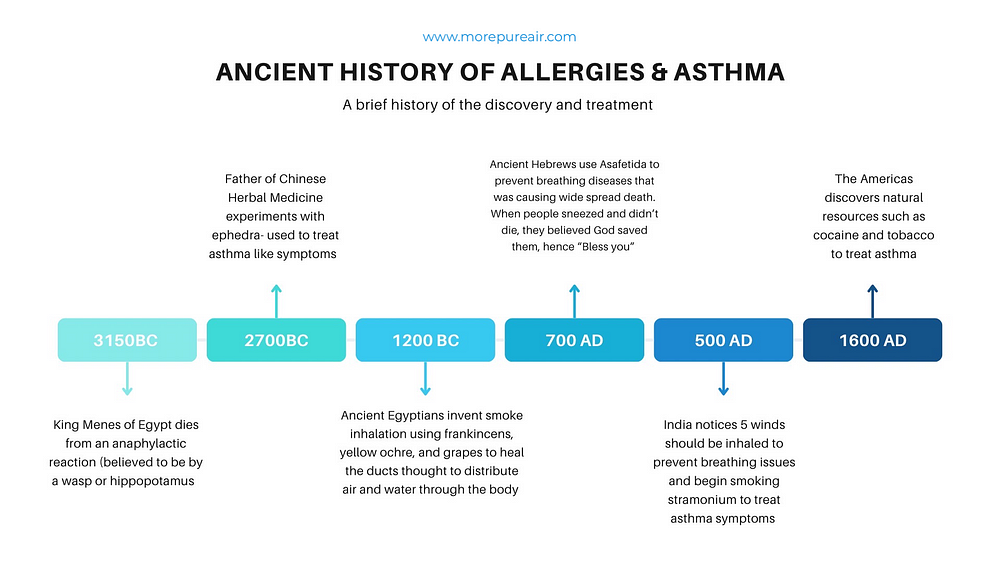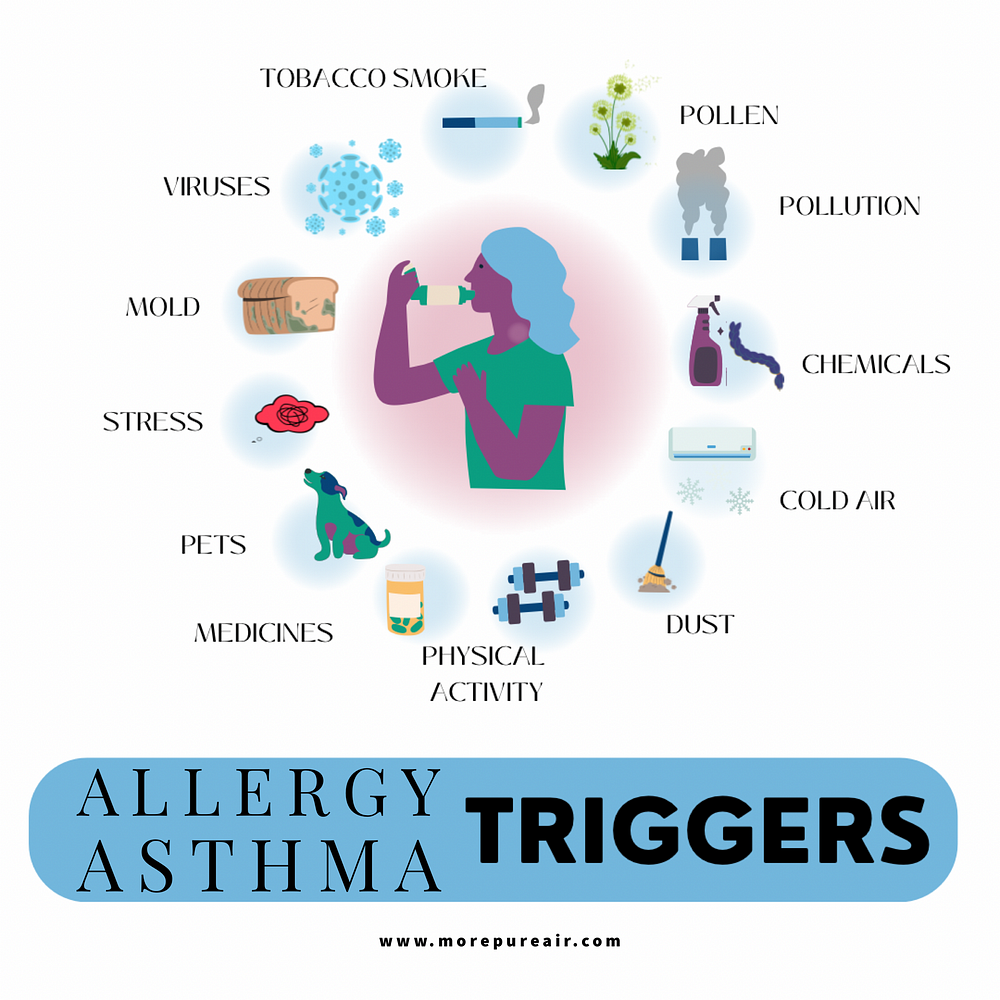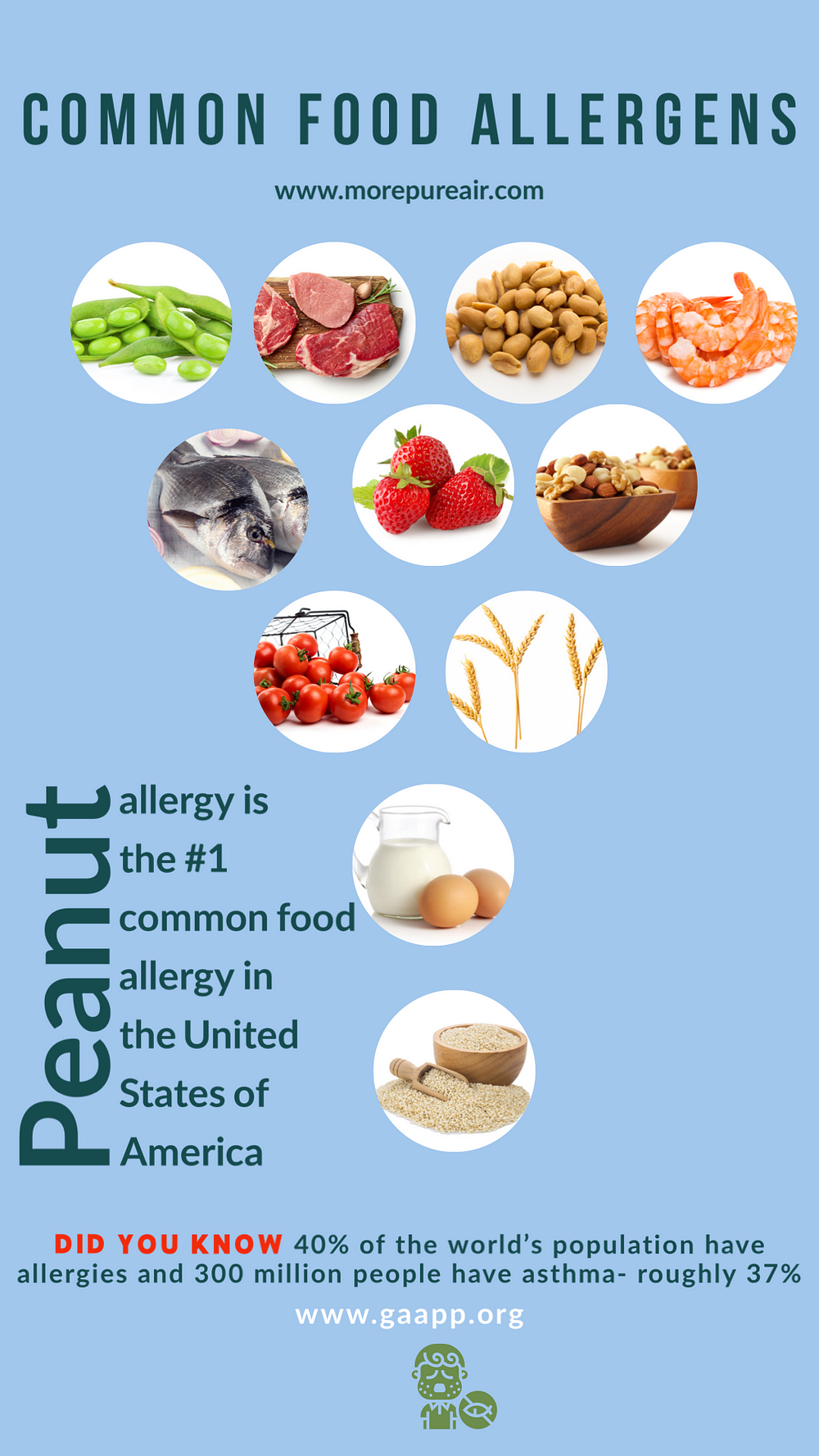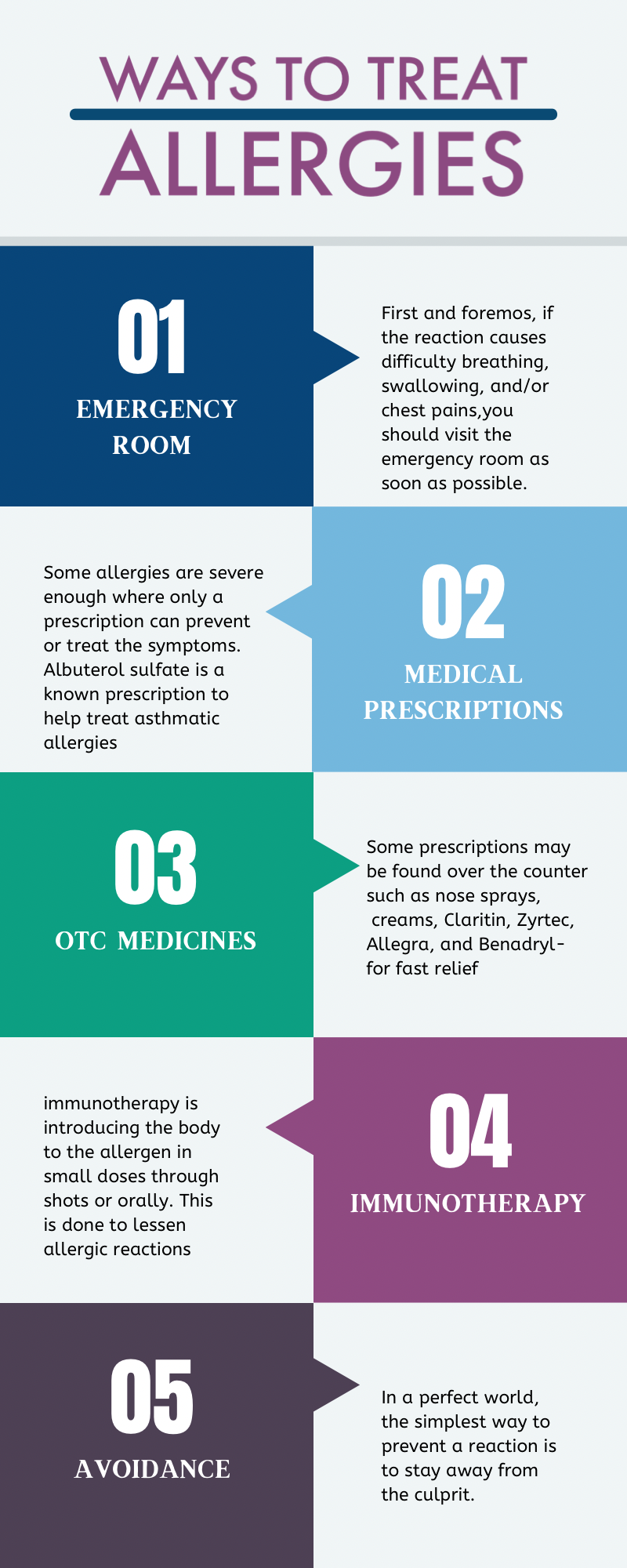The Pure Project
The Pure Project
DID YOU KNOW asthma is the leading cause of chronic illnesses and disabilities in children of the United States of America?
As such, allergies are not too far behind — with forty percent of Americans suffering from yearly reactions.
Americans who have chronic allergies sometimes even form asthma, also known as allergic asthma— a two for one with nothing special about the deal.
There are many factors that comes to surface when dealing with allergens. Foods, molds, nature, animals, synthetic hair, nicotine, and dust particles are some of the top causes of severe allergic reactions.
Once undergoing a reaction, medical procedures and prescriptions are in place to help control symptoms and prevent unwarranted circumstances.
But before we dive into those, let’s take a further dive into the world of allergies and asthma.
WHAT ARE ALLERGIES
Allergies is a defense reaction of the immune system to foreign substances. The foreign substances such as pollen, dust, synthetic hair, pet dander, tobacco smoke, peanuts, tomatoes, chemicals, and mold enter the host through the air or direct contact of the body. The body then signals the release of antibodies to fight those substances. In return a reaction such as sneezing, coughing, or hives may occur to help aid the body in ridding the foreign substance.
Allergies in recent times were first uncovered over 150 years ago by a man who believed he was experiencing uncontrollable sneezing due to pollen. He set off to prove his theory by testing himself and confirmed it was indeed pollen.
Since then, scientists and doctors have discovered a multitude of harmless objects entering the human body and causing unexplained inflamed reactions.
WHAT IS ASTHMA
Asthma is a long-term medical condition that causes inflammation in the lungs. This is due to the abnormally thin passages that connects the airways to the lungs. The result includes chronic coughing, wheezing, shortness of breath, and difficulty breathing.
WHAT IS ALLERGIC ASTHMA
Allergic asthma is when asthma occurs only due to an allergic reaction. Without the allergy in place, asthma would not be present. In this type of lung condition it is best to diagnose and treat the allergy before attempting to treat the asthma. In time, the asthma would improve or disappear altogether when dealing with allergic asthma.
BRIEF HISTORY ON ALLERGIES AND ASTHMA

Something similar to an allergic reaction was first recorded between 3640 and 3300 BC during the reign of King Menes, the first Pharoah of Ancient Egypt.
King Menes established Egypt’s first dynasty and changed the course of the Nile River in Lower Egypt.
The name Menes was given to him by a third century BCE historian from Egypt. He is also known as several other names including Aha — the name on the oldest tombstone at Saqqārah, cemetery for Memphis, fifteen miles west of Cairo.
King Menes served sixty-two years before succumbing to an anaphylactic reaction thought to be from a wasp or hippopotamus. Some Greek scholars even write him as suffering from dog bites and crocodile saliva.
In China, during the twenty-eighth century BCE, a folklore began for the emperor, Shen Nong (Divine Husbandman), who was also believed to be an inventor and scientist. He was widely known for his contributions in herbal practices during that time.
Shen Nong experimented with herbs until discovering the taste of ephedra, which was used to treat asthma-like symptoms during his time.
The Nei Ching Su Wên, an internal Chinese medicine book, discovered two thousand years ago records of breathing noises while one is sleep and awoke, plus still and moving.
Egyptians noticed the importance of a healthy upper respiratory system and documented their findings in the Ebers Papyrus— an Egyptian herbal medical book dating back to 1550 BCE. The book revealed a more proper approach to medical practices. The book contained many remedies including ones for treating crocodile bites, information on the circulatory system, and how to treat vessels to maintain a good heart.
The Greek-Romans created the code of Hammurabi in 1792–1750 BC. It documented asthma-like symptoms and noted those symptoms were caused by sin and demon possessions. The usage of magic and repentance was the main cures.
A more scientifical approach was established around 460–377 BC by Hippocrates who influenced much of western medical ideologies. He coined the term Asthma. He noticed those who panted a lot in their environments had hunchbacks. Hippocrates further identifies asthma by blood numbers, phlegm, yellow bile, and black bile. He was the first to link emotions to the respiratory system and believed asthmatic symptoms occurred due to an evil humor rising in the brain, passing through the pituitary gland, swelling in the naval passages, flowing into the lungs, which would be blocked by catarrh.
Hippocrates declared to cure asthmatic reactions one would have to shield himself against his own anger. He documented that treatment included drinking owls' blood and wine.
Ancient Hebrews were the first to practice a preventative care to treat sicknesses and illnesses. It is written in the Old Testament of sanitation practices and food choices to prevent the illnesses during that time. The Talmud describes the usage of hiltith, the Arabic word for asafetida- an oriental plant believed to prevent diseases. Asafetida was used to prevent and treat lung diseases such as asthma, whooping cough, and bronchitis. The Midrash describes sneezing to be very dangerous due to a widespread of death from people who sneezed. This was where the phrase “bless you” derived as it was believed God saved those who continued to sneeze and didn’t die as it is written in the Old Testament God gave life by breathing in the nostrils.
India described the five winds as an important functioning system that needed each other, or the body would start filling up with juices and the host would become ill. India believed in smoking stramonium to treat asthma. This practice was later adopted by European culture.
Herbal remedies in the Americas flourished in 1600 AD when transporting goods across the globe became increasingly popular. Cocaine and tobacco was included in those shipments. Researchers and physicians used those goods in hopes of treating asthma.
In 1950 the first therapeutic aerosol device was created to deliver medicine to the lungs.
Up until the 1960s a small percentage of cocaine was used in therapeutic aerosols to help treat asthma symptoms along with allergic asthma.
STATISTICS
Allergies, asthma, and allergic asthma is predominant across the world. Many documented and undocumented people alike suffer from the effects of allergies and asthma.
Globally 300 million people have asthma. That’s 37% of 8.4 billion.
- 30% American adults have allergies
- 40% American children have allergies
- 11% American adults have food allergies
- 7.5% American children have food allergies
- 7% American adults have asthma
- 8% American children have asthma
- 90% American households have detected a pet allergy
- 7.7% American adults reported hay fever.
- 9.2 million American children reported skin allergies (hives, eczema)
TRIGGERS


SYMPTOMS FOR ALLERGIES AND ASTHMA
Allergies:
- Sneezing
- Runny and/or stuffy nose
- Watery eyes
- Skin rashes such as hives
- Chronic dry coughing
- Nasal blockage and congestion
- Itchy eyes, roof of mouth, or nose
- Headache or pressure between the eyes and round the nose
- Sore and/or scratchy, itchy throat
- Abdominal pain after eating (food allergies)
- Difficulty breathing
- Swelling
- Hay fever
Asthma:
- Shortness of breath
- Chest pain
- Tightness in Chest
- Difficulty taking deep breaths
- Wheezing
- Trouble sleeping caused by shortness of breath, coughing or wheezing
- Chronic coughing
- Persistent dry cough
- Breathing attacks that are worsened by a respiratory virus- cold/flu
- Fatigue
DIAGNOSING ALLERGIES AND ASTHMA
First and foremost, if you or a loved one is experiencing a life-threatening attack, please do not hesitate to dial 911 and/or try to get to the nearest emergency room. Please do not wait for your symptoms to go away. If you do not have the proper medical tools and prescriptions to stop an asthma attack it is important to quickly seek the proper help.
When to seek help?
See your doctor:
- If you have a persistent dry cough, wheezing, and shortness of breath that lasts more than a few days, or any sudden persistent signs, that means it is time to seek professional and medical help.
- Early diagnosis can lead to a normal quality life and save you from potential lung damage and other complications associated with allergies and asthma.
TREATMENT
Living with the uncertainness of asthmatic triggers can cause a great deal of stress. Thankfully other treatments and procedures such as emergency room visits, over-the-counter medicines, medical prescriptions, and immunotherapy are in place to maintain a normal lifestyle.
Immunotherapy is the process of introducing the allergen into the host through allergy shots and medical prescriptions.
Allergy shots are the most established form, while Palforzia is the only food immunotherapy approved by the FDA.
The USDA guidelines recommend parents to introduce allergen foods to babies beginning in their first year to prevent the development of food allergy.

MAINTENANCE
After going through the awareness phase and understanding the diagnoses and treatment options it is important to maintain a lifestyle suitable to prevent a reaction and/or attack.
Staying up to date with doctor appointments for Allergy and Asthma offices in local areas is one way to maintain a healthy lifestyle. Doctors are able to prescribe specific medication to help reduce symptoms that may increase the years in life.
Currently there is no cure on the market for allergic asthma, though prescriptions such as albuterol, Anti-immunoglobin E, allergy shots, and leukotriene modifiers are prescribed after thorough medical examinations targeted to diagnose the lung condition.
Physical activity sometimes triggers exercise-induced bronchoconstriction, and one should take precautions before engaging in such activities. This type of asthma is considered moderate to severe. Using the inhaler before and after intense physical activity can reduce asthma attacks.
Likewise, physical exercise is beneficial in reducing inflammation and improving lung conditions.
Seasonal allergies can be triggered yearly without the correct procedure to maintain pure air and keep away from outdoor allergens.
Over-the-counter medications such as Benadryl reduces sneezing, coughing, hives, runny nose, and itchy eyes accompanying the outdoor explorations during allergy season.
It may be difficult to stay clear from the allergen altogether depending on which category the allergen is classified in, such as pollen.
WHAT IS THE PURE PROJECT?
In reference to the information on allergies and asthma, The Pure Project was created as a new, yet historical way to relieve toxins from the indoor air.
Pure air is essential in order to accomplish and enjoy daily household activities.
With this project, the goal is to scout and discover the forms of natural waxes derived from different regions.
Candles is an age-old method that creates light and removes toxins from the air.
I am excited to begin the journey of showcasing our dedication to introducing pureness to the company, community, and consumers.
“T H E P U R E P R O J E C T” derived from our mission statement and core beliefs.
We value transparency and believe its power to build and maintain customer relationships.
This is the beginning of the journey to include easy and consistent fresh air inside of households across the globe.
While I am dedicating my first project to the upgrade of CANDLE, a company by Enkredible Life, I wish to include more companies and projects in the continuation of providing pure air in every household.
You may discover more about The Pure Project at www.morepureair.com.
Comments
Post a Comment